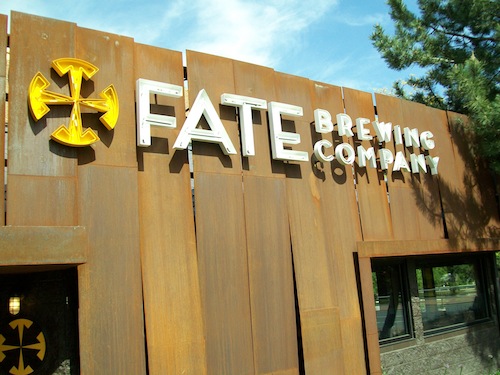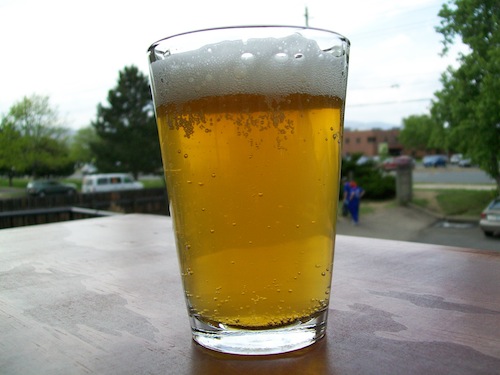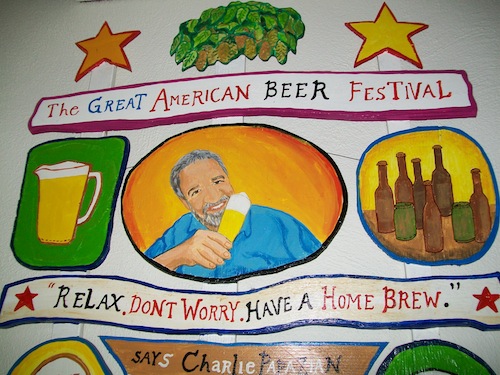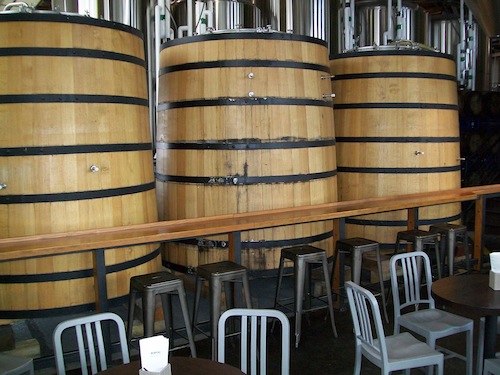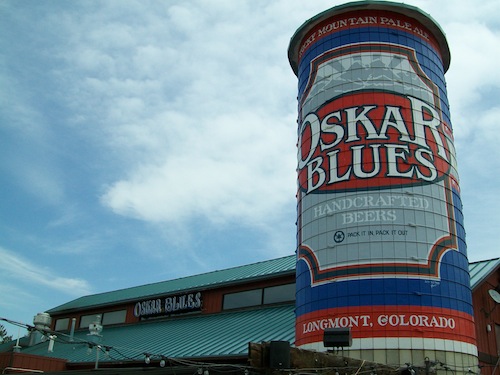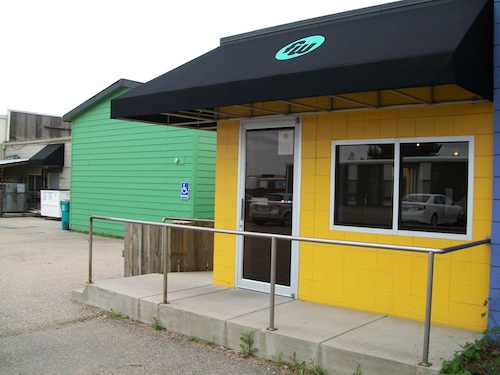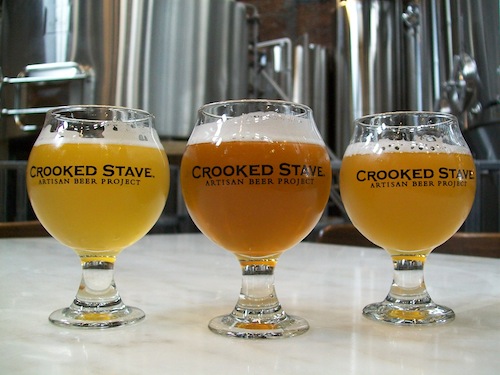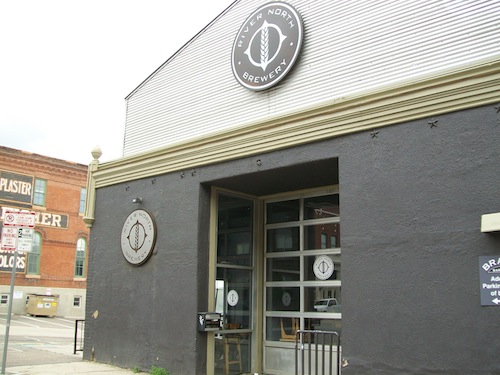Ever since I first became a certifiable craft beer geek about six years ago, the Front Range of Colorado has been at the very top of my dream destinations. Some people might find that a little surprising—what about say, California? The Portland area? Asheville, North Carolina? Even Belgium itself? But no, I always knew I would eventually be headed to Colorado.
The reason is a combination of density and incredible variety. In the hour-long drive between Denver and Fort Collins, there are a staggering number of great breweries to visit. The options available to a traveler border on the absurd. In the greater Denver area alone, there are more than 50 breweries in operation today, and plenty of others in the planning stages. Boulder and Fort Collins add almost 40 more. Factoring in all the small towns between these cities, the number swims easily past 100. And none of those breweries is more than an hour or so from any other. It’s one of the most beer-rich places on Earth.
And so, when I finally made my trip a few weeks ago, I was determined to hit as many of the important and relevant breweries as possible. It would be impossible and likely deadly to hit them all, so I apologize in advance for all the important ones that I missed. What follows is the chronicle of one man with occasional accompaniment, soaking in the best of what Colorado’s craft beer scene has to offer. Consider it your guide.
Day 1: Boulder
I touch down in Denver’s airport well before noon on a Monday morning, eager to get on the road. Rather than remaining in Denver, I must first drive straight to Boulder for several reasons. For one, it’s where my welcoming friends are situated, which makes it my base of operations for the trip. And secondly, I have an early afternoon interview scheduled with the founder of Avery Brewing Company, so my first stop has been decided for me. The first beer will be downed at Avery.
Avery Brewing Company
The Avery tap room is not as large as you would expect for a brewery of its national scope and reputation, and this will become a running theme of the trip. Everywhere you go, there are constant reminders that craft breweries are still comparably small businesses, even those with national distribution. With very few exceptions, these are not megaliths but overgrown homebrew projects.
At the rather humble tap room, I scarf down sweet potato tots and green chile, laying the foundation for a day full of beer. I’ve done these types of trips often enough in the past to know that it’s important to eat, and often. In terms of beer I stick to tasting taproom exclusives you won’t see on store shelves, which include a session IPA and a very tasty coffee stout made with Ethiopian Yirgacheffe.
Notable beer: One standout is called Currawong, an unusual black saison brewed with “Tasmanian pepper berries.” It’s a skillfully brewed Belgian ale with a massive peppery aroma but restrained flavors that don’t overwhelm the base beer.
Upslope Brewing Company
Adam Avery points me in the direction of one brewery, but as I imagine must happen regularly in these towns, I run into another one on the way and decide to stop. The location is Upslope’s east Boulder expansion, only a year or so old and removed from the main road in an industrial park. On the walls, a sprawling mural starts with “ale” and “lager” before branching out into a visual history of all beer styles, citing local Colorado examples along the way. The brewery has quickly become one of Boulder’s most commercially successful thanks to their approachable flagship styles, but they also like to experiment and collaborate.
Notable beer: I taste a couple of collaborations, including a porter made in collaboration with Denver’s TRVE Brewing Co., but my favorite is the subtly spicy Belgian Blonde Ale made in collaboration with Italian craft brewer Birra Toccalmalto. Perhaps Italy should be on my beer bucket list as well?
FATE Brewing Company
FATE is a bit of an odd place to describe, a brewpub and restaurant that trends toward the experimental and mixes the aesthetic of an upscale gastropub with an easygoing sports bar. Modernist art adorns the walls but classic rock plays over the bar speakers. The beer is adventurous and bold: a salted gose, high-gravity Belgians, and a coffee IPA are just some of the usual suspects. I meet my friends/hosts here and we pause to dine on chicken and waffles dipped in spiced honey. It really is an odd place, but the beer list is quite ambitious.
Notable beer: Not everyone agreed with me on this one, but I walked away very impressed by FATE’s Coffee Kolsch. If you’re thinking “What an odd style to brew with coffee,” that was my reaction as well. As it turns out, though, I enjoyed it significantly more than several coffee IPA’s I have sampled. The contrast between the light, crisp malt character of the kolsch and the flavor of coffee offers a clear delineation between two separate flavors that still complement one another in a natural and inviting way.
Kettle & Stone Brewing Company/Vindication Brewing Company
Things change pretty quickly in the Boulder beer market. When I visited this place only a few weeks ago, the name was still “Kettle & Stone,” but the name the business had used for 11 months was already on its way out after they received a cease-and-desist letter from Stone Brewing Co. in California. Rather than fight one of the giants of the craft beer world, Kettle & Stone decided to simply change its name to the rather chippy-sounding “Vindication.”
After leaving FATE, we drop our cars at home and trek to this nearby beer destination. This one has the look of a neighborhood brewpub, although it’s primarily a tasting room. Like several other area brewers they’re very into natural product, loudly proclaiming their brews as “chemical free, with no anti-foaming agents,” if that’s important to you. Also: There’s free popcorn.
Notable beer: There were several tasty, hop-forward beers on display here but the best is a red IPA called Go Ask Alice. Fruity El Dorado hops give it some uniquely tropical characteristics.
Asher Brewing Company
Only a few blocks from my sleeping quarters, Asher couldn’t have been much more convenient. It also couldn’t have been much more inviting. Looking a bit like a dank, sub-street level neighborhood dive bar where one might wile away a weekend afternoon in Chicago, Asher was continuously filled with regulars and locals tossing bean bags and having a great time with one another. Every other person who enters generates “NORM!”-like cries of recognition. One of those people is a guy named Jon Paul, who graciously allows me to snap a photo of him next to the beer named in his honor, “Jon Paul Ginger.”
Notable beer: Perhaps it’s because my taste buds are tiring at this point, but my favorite is the humble Kolsch, a creamy session brew with a light kiss of grainy sweetness. It goes to show that the best beer from any given brewery is the one you’re in the mood for at that moment.
Day 2: Boulder
The morning of day two, I wake up early and head to a downtown Boulder breakfast restaurant to begin laying another food foundation. I find beer trips tend to call for simple foods, and in quantity: A huge skillet loaded with eggs and starchy hash browns is ideal. After breakfast, I stroll around town until it’s opening time at…
Twisted Pine Brewing Company
Perhaps more-so than any of the breweries so far, Twisted Pine embodies the aesthetic of its city. Very cozy and very hand-carved looking, the low ceilings of its tap house are home to many members of the city’s itinerant, aging hippie population. Here, the brewers are famous for a few chile beers in particular, especially the “Ghost Face Killah,” which has achieved an especially notorious reputation. The infamous beer isn’t on tap when I arrive, and the bartender offers to open a full 12 oz bottle. “No thanks,” I assure him. “I can do without.”
Notable beer: The less-intense chile beer “Billy’s Chiles” still packs a good punch, but my favorite is unexpectedly the Tumble Wheat, a fresh, unfiltered what beer brewed with locally sourced sage. Its unexpected herbal character added depth to an already refreshing wheat ale.
BRU handbuilt ales
Whereas Twisted Pine has the look of a ski lodge, BRU has a much more modern aesthetic, a fusion between gastropub and Neapolitan pizzeria with visible kitchen and a big, wood-burning pizza oven. The menu is a couple of notches higher in terms of sophistication, and the beer follows suit, with selections that include a “patersbier” brewed with sour orange and coriander or “Nymeria,” a pale ale with unusual, experimental hops that tasty fruity and almost musty. Sitting out on the patio, I drink in a beautiful day with the mountains only a few miles away to the west, eating fresh-baked bread dipped in whipped butter with mustard seed.
Notable beer: Many of the beers here are modified with spices or fruit, and the tastiest was likely the 5290 Saison, brewed with tangerines. The fruit adds a very crisp, citrus zest presence that pairs perfectly with a traditionally dry, funky, French-style saison.
Wild Woods Brewery
In terms of “tough to find,” Wild Woods might have been the best-hidden brewery on this entire trip. Recessed in the back of an industrial complex, it’s not a place you’re ever going to run into unless you already know where it is. Still, despite the fact that I showed up only two minutes after its opening, there were already a few local beer geeks sidling up to the small bar. The beer here is likewise built around locally sourced additives, such as the sweet, oak-aged Ponderosa Porter, which is brewed with vanilla bean, or the lightly smoked Campfire Red Ale.
Notable beer: The Treeline IPA is a well-balanced American IPA that is dry-hopped and conditioned with an interesting addition: Juniper berries. The berries reinforce the pine notes of this ale’s hop profile in particular, giving it just a little bit of the botanical character of some gins.
Day 3: Denver
It’s Wednesday morning and I’ve covered the most important destinations in Boulder (apologies to Mountain Sun, which I intended to visit but never reached). My brother joins me in Boulder early this morning, and we depart to spend the day in Denver, a city with far too many great breweries to visit even if I had spent all five days there. We’ll make it to as many as we can while also taking in a Rockies game at Coors Field, starting with lunch at…
Wynkoop Brewing Company
From a historical perspective, a visit to Wynkoop is a must. Founded in 1988 by future (and current) Colorado Governor John Hickenlooper, this brewpub kicked off Colorado’s craft beer revolution. The walls are adorned with all sorts of brewing history, including a mural dedicated to luminaries such as “Beer Hunter” Michael Jackson and American Homebrew Association founder Charlie Papazian. Today, Wynkoop is still a popular local destination for both food and beer, only a few blocks south of the ballpark. Talk about your brewery-dense locations: There are around a dozen other brewers within a mile. It makes for a very convenient day, as we ditch the car in a downtown parking garage and spend the whole time on foot.
Notable beer: Of the few we taste, the winner is B3K Black Lager, a dry, roasty schwarzbier, which is a style I wish we saw more often in American craft brewing. This one is highly acclaimed: Two Great American Beer Fest medals for the hometown brew.
Great Divide Brewing Company
As we trek past Coors Field the sky opens up and it begins to pour, pelting us with dime-sized chunks of hail. We high-tail it to Great Divide just as the tornado sirens begin sounding, putting our evening ballgame in definite jeopardy. Thankfully, the brewery is there to offer us refuge and a place to drink.
It’s a bit of an odd place. Like Avery, it’s one of Colorado’s larger regional breweries, but the tap room is quite small. Everyone is having a good time inside as the storm passes by, including all the bartenders and staff, who are all drinking beer—every single one of them. As the place fills up, a particularly eccentric-looking bartender calls out to the entire place and implores them to be quiet, then yells the following hypothetical question: “Would you rather shit in your hand and eat it, or have to suck off a goat? You’re allowed to throw up the shit.” Nobody is particularly eager to answer him.
Notable beer: My brother is partial to the big, boozy Yeti Imperial Stout, but my favorite is the Franco-Belgian ale, Colette. If it’s not yet obvious, I’m a sucker for a well-made farmhouse ale/saison, and the slightly tart Colette is packed with classic flavors of clove and hay while still being surprisingly refreshing for a 7.3% ABV beer.
Epic Brewing Company
This Walnut St. brewery ends up being a few blocks further away than we realized while departing from Great Divide, but seeing as the deluge has stopped, it’s hard to complain too much. It also ends up being one of my favorite stops of the trip, an absolutely beautiful little building that has been lovingly erected in a former warehouse. The oak foudres and long, sleek bar create a thoroughly modern and inviting-looking space. The beer, meanwhile, is fresh, innovative and exciting, from the “Brainless” series of imperialized fruit beers to the delicious Escape to Colorado IPA with tropical Mosaic hops. Do not miss out on this place if you’re visiting Denver.
Notable beer: I’d heard before my arrival that I needed to try the barrel-aged imperial stout known as Big Bad Baptist, and man, those people were right. It’s an absolutely masterful beer with just the right amount of bourbon barrel character to elevate rather than overwhelm an amazing imperial stout redolent with coffee flavors in particular. This is something special.
Falling Rock Taphouse
Not a brewery, but the site of our dinner before the Rockies game, Falling Rock is famous nationwide as one of the very best beer bars in the country. Walking into the fairly small establishment, it’s easy to see why it makes such a big impression—every single wall is absolutely covered in bottles, cans and tap handles, more than 2,200 in total according to the bar’s website. Of course there’s a downside as well, as the hoard of beer geeks can make it difficult to get whatever it is you came in for. Case in point: The first three beers I try to order are all unavailable. Even with daily updates to the tap list, it’s always going to be unpredictable. Also, and I must point this out: ONE toilet, in a single unisex bathroom? For the entire beer bar? REALLY? How is this possible?
Notable beer: It obviously wasn’t my first choice, but the Dry Dock DIPA makes for a serviceable consolation prize. As do the green chile tamales.
Coors Field
For being in the heart of such a fantastic beer city in such a prolific craft beer state, the selection at the ballpark is as limited as the name of the field would suggest. Midway through the game I go for a full lap of the main concourse in an attempt to track down any vendors of local craft beer, but instead I mostly find Blue Moon tie-ins. Anheuser is also unexpectedly present, operating in a covert manner without any real signage. In the entire park, the only craft brews I spot on the main concourse are solitary bottles of Odell 90 Shilling and Oskar Blues Dale’s Pale Ale—neither of which are even from Denver. It’s a disappointment, to say the least. Even a park like Busch Stadium in St. Louis offers a full range of beers from local brewers such as Urban Chestnut. To the Rockies, I say: Step up your beer game if you want to do Denver proud.
Check out the next page for the breweries in Fort Collins and Denver.
Day 4: Longmont, Fort Collins
I’m not done with Denver yet, but since my brother must return to Boulder, I drop him there and head north instead of south. It’s a straight shot through Longmont to Fort Collins, which promises still more breweries, including the biggest I’ll visit on the trip. But first things first, it’s breakfast and an A.M. stop at…
Oskar Blues
If the word for Oskar Blues’ exterior is “rustic” or barn-like, then the adjective for its interior is “busy.” There’s kitschy stuff covering every square inch of the place—even a “Zoltar” machine straight out of Tom Hanks’ Big. It has a very “Colorado” vibe that is difficult to put into words.
As I scan the room, I note the stickers from breweries all over the country slapped on every available surface. There’s even one from Chicago nano-brewer Spiteful Brewing, a business 1,000 miles away operating with a miniature, 2.5 barrel brewhouse. It’s probably safe to say the owners made this very same trip at some point.
Notable beer: Many of these beers I’ve had before, but the tap room exclusive Donkey Tail Rye Pale Ale provides a nice change of pace, as does a “small stout” called Black Mamba, which is made from the second runnings of the brewery’s well-known Ten FIDY Imperial Stout.
Left Hand Brewing Company
From Oskar Blues, Left Hand is only a couple of miles away on the other side of Longmont. Their tap room more accurately captures the Western feeling of the area than any I’ve visited so far, with a constant rotation of classic bluegrass music playing softly in the background. In the bathrooms, unique stall doors are made of double panes of transparent glass, filled with striated veins of malted barley. It’s an odd place to see arts and crafts applied in a brewery setting, but something I’ve never seen elsewhere.
Notable beer: The brewery’s “Fade to Black” series is always interesting, a rotating procession of unique dark beers. I sample the newest, Fade to Black Vol. 5, a black rye ale with plenty of peppery rye spice and undertones of black licorice.
Odell Brewing Company
Moving onto Fort Collins proper, we’ve got another tap room that evokes a rural, barn-like aesthetic from the outside, but the inside is clean and modern. On the large, multi-tiered outdoor patio there sit a regularly scheduled variety of local food trucks: Today is “The Waffle Lab,” frying up doughy creations to soak up the beer. I order a big slab of Belgian waffle, covered in rosemary sausage gravy. It’s just what the doctor ordered.
Notable beer: The herb-infused gravy pairs well with a St. Lupulin Pale Ale, with its lemon citrus and floral notes. This hoppy pale ale is actually better balanced with biscuity malt than its name might lead you to believe. Lupulin, if you were not aware, is the chemical compound in hops responsible for the plant’s bittering capacity.
New Belgium Brewing
I leave my car behind, as Colorado’s biggest craft brewer is only a few blocks away on foot. New Belgium is the true giant of this scene, absolutely dwarfing all of the other craft breweries with its massive production facility, which sprawls out over a compound of many buildings. As soon as one steps onto the grounds you’ll see two or three tour groups heading in different directions—they leave the main tap room hourly, and yet you still need to sign up a month in advance to reserve a time. That’s how popular this tour (and craft beer by extension) have become. I know I’m not going to be here long because I’m not going on the tour, so I simply settle in on the patio to have a quick beer and appreciate the attractive facility.
Notable beer: Yuzu Imperial Berliner Weisse isn’t the most beloved of NB’s Lips of Faith series, but it’s what I find myself in the mood for at this moment. It’s lightly tart, perhaps a little bit less so than some of the more sour Berliner weisse’s out there, with lots of funk and fruit flavors. The yuzu is east Asian citrus, but I get a fruit flavor out of this that reminds me more of fresh pear. Regardless, it’s pretty refreshing.
Funkwerks
It would be difficult to find a starker contrast between two places than comparing New Belgium with Funkwerks, a squat little building painted in random, rainbow colors as if they’re compensating for the uninspiring architecture. Regardless, it’s hardly the looks that are important. The brewers at Funkwerks are the resident Belgian beer masters of Fort Collins as the name would imply, and the menu involves a range of saisons and strong ales. They don’t have the largest number of brews, but in the course of a visit one gets a sense that the focus is on doing a few specific things well.
Notable beer: Tropic King is one of Funkwerks’ most popular brews, an imperial saison brewed with Rakau hops from New Zealand. It’s an especially fruity, funky and exotic Belgian ale that skillfully blends alcohol presence with spice and an unusual hop character.
Day 5: Denver
I call it a day fairly early in Fort Collins, perhaps feeling the trip’s fatigue beginning to set in. I have one more day on Friday to check off a few of the breweries I missed in Denver, interspersed between checking out a few historic movie theaters.
Crooked Stave Brewery
This brewery proves harder to find than expected, because I’m looking for a stand-alone facility when this isn’t the case at all. As it turns out, the brewery is housed within “The Source,” a former ironworks that looks for all intents and purposes like a broken-down, graffiti-covered factory from the outside. Inside, however, it gleams with stainless steel and aluminum, filled with micro businesses such as a taco restaurant, a cheesemaker and an artisan liquor store. Hipsters mill at all of the businesses and adjust their waxed mustachios to just the right angles. There’s even a rabbit hutch with animals available for petting. I assume the rabbits serve some other purpose but I’m unable to deduce what it might be.
Crooked Stave, meanwhile, is wedged into one of the corners, looking very industrial and metallic. The focus here is sour ales, and everything I taste is appreciably puckering and funky—some more-so than others. It looks like a factory that produces nothing but sours, and some beers can even be tasted by vintage: The fresher, the more puckering is the general rule.
Notable beer: There’s a lot of quality here, but the St. Bretta Spring stands out for its beautiful balance. Moderately tart, the perfumey aroma is heavy with tangy citrus from a dosing of “Minneola tangelo,” a cross between grapefruit and tangerine I’ve never heard of before this moment. It’s then conditioned with brettanomyces in the brewery’s oak foudres. Very refreshing, wonderful spring/summer beer.
River North Brewery
This one is so small, its taproom is basically housed within a small garage or shed, with total space that would fit two cars—and that’s including the bar. Like a Denver version of Funkwerks, these guys are Belgian beer devotees, although their interest seems to run less toward the traditional and more toward making “Belgian-ized” versions of popular American beer styles. To whit, there are items on the menu like a Belgian-American IPA or a Belgian-American stout. Sitting and sipping a few tasters at the bar, within only a few feet of the street, you sort of feel like you’re out on your own front porch or drinking in the garage of your homebrewer friend. Random note: Denver’s Church of Scientology is right across the street.
Notable beer: “Belgian stout” still isn’t something you see all that often, but a beer like River North’s Avarice proves the style definitely has something to offer when done well. It’s great stuff primarily because the base stout is tasty, with deep coffee flavors that are only subtly modified by the spicy Belgian yeast. It’s just Belgian enough to let you know that there’s something unique going on.
TRVE Brewing Company
Denver’s resident “heavy metal brewery,” TRVE is a truly unique place. The tap room is like a long cavern that reaches back from the door, getting progressively darker and dingier as you go. They claim to “channel Loki and embrace chaos,” and that certainly applies to the adventurous beer selection. The menu descriptions are great fun to read—the DIPA is described as being like “a caravan of creedsmen marching through a hasheeshian landscape.” On one side of the communal wooden tables, black and white photos of dilapidated, abandoned farm houses look like some sort of Stephen King tribute. On the other side sit barrels named after Viking heroes. I would be lying if I said I didn’t love the theming.
Notable beer: The Prehistoric Dog is a gose, an uncommon beer style that involves the unusual addition of salt. In this case, they boast of using “Hawaiian black lava salt and coriander,” but the important thing is that it tastes good—refreshing, but with an oddly savory quality. Licking my lips afterward, I can taste the lingering salt. It’s the last official brewery I visit on my tour.
End-of-Trip Awards
Most unexpectedly profane brewery staff: Great Divide Brewing Company
Best tap room aesthetic: Oskar Blues, Epic Brewing Company
Most pleasant surprise on all fronts: TRVE Brewing Company
Best thing I ate: Green chile tamales, Falling Rock Taphouse
Most relaxing vacation moment: Beer and fresh bread on the patio of BRU handbuilt ales
Wish I could have gotten to: Mountain Sun, Strange Brewing, CAUTION: Brewing, Equinox Brewing, Black Bottle Brewery
Top 3 beers of the trip:
1.Big Bad Baptist, Epic Brewing Company
2.St. Bretta Spring, Crooked Stave Brewery
3.Avarice, River North Brewery
